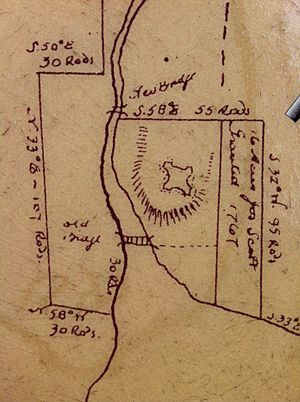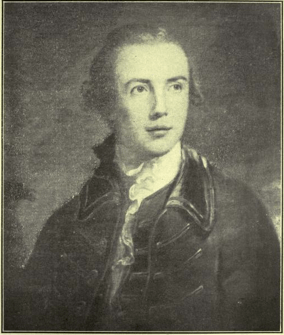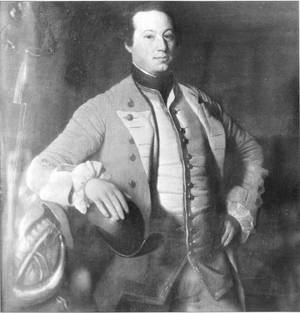Fort Sackville (Nova Scotia) facts for kids
 |
|
| Established | September 11, 1749 |
|---|---|
| Location | Bedford, Nova Scotia, Canada |
| Founder | John Gorham (military officer) |
Fort Sackville was an important British fort located in what is now Bedford, Nova Scotia. It was built in 1749 during a time of conflict known as Father Le Loutre's War. The fort was placed on a hill overlooking the Sackville River, right next to where Scott Manor House stands today. Its main purpose was to protect the new British settlement of Halifax from attacks by the French, Acadians, and Mi'kmaq people.
The fort was made up of several buildings, including a blockhouse (a strong, small fort), a guard house, and barracks that could house 50 soldiers. All these buildings were surrounded by a strong fence called a palisade. There was also a rifle range nearby for training. The fort was named after George Germain, 1st Viscount Sackville, a British official.
Contents
Why Fort Sackville Was Built


Even though the British had taken control of Acadia (which is now Nova Scotia) in 1710, most of the people living there were still Catholic Acadians and Mi'kmaq. This changed when Edward Cornwallis arrived in June 1749 to start the city of Halifax.
This period marked the beginning of Father Le Loutre's War. The British mostly stayed in Halifax at first. They tried to build another settlement near Lawrencetown Beach but gave up quickly because of threats from the Mi'kmaq. Four years after Halifax, the town of Lunenburg was also founded.
To protect these new British settlements from attacks by the Mi'kmaq, Acadians, and French, the British built several forts. These included Citadel Hill in Halifax (1749), Fort Sackville in Bedford (1749), forts in Dartmouth (1750), Lunenburg (1753), and Lawrencetown (1754).
Within a year and a half of founding Halifax, the British also took stronger control of the Nova Scotia peninsula. They did this by building forts in major Acadian communities. These included Fort Edward in present-day Windsor, Fort Vieux Logis in Grand Pre, and Fort Lawrence in Chignecto. There was already a British fort at Annapolis Royal.
Fort Sackville During Father Le Loutre's War

On September 11, 1749, Governor Cornwallis sent a New England Ranger named John Gorham (military officer) to build Fort Sackville. The fort's main job was to protect Halifax from attacks by the Wabanaki Confederacy (a group of Indigenous nations), Acadians, and French. Gorham's Rangers were mostly Indigenous people from Cape Cod, Gorham's hometown. An armed ship stayed with them while the fort was being built.
About five weeks later, Cornwallis wrote that the important posts at the head of the bay and Minas were now secure. Lieutenant Robert Pateshall of the 40th Regiment of Foot was also stationed at Fort Sackville. Gorham used the fort as a base to search the area for enemies during the conflict.
Cornwallis later ordered Gorham to Piziquid (now Windsor) in November to help with the Siege of Grand Pré, where Mi'kmaq and Acadians were attacking. Gorham also supervised the building of a road to Windsor, which was finished by December 17. He left again in January 1750 and was ordered to Piziquid once more in March to build Fort Edward (Nova Scotia). On his way, he fought in the Battle at St. Croix with the Mi'kmaq. Gorham needed help from Captain William Clapham, who arrived with rangers from Fort Sackville.
In early 1750, Captain Alexander Murray commanded Fort Sackville. Later, in September 1751, he took command of Fort Edward (Nova Scotia).
In August 1750, Captain Francis Bartelo replaced Gorham at Fort Sackville. However, Bartelo was killed the next month in the Battle at Chignecto. Gorham returned to Fort Sackville by March 1751. In the summer of 1751, Gorham built the first registered ship in Halifax, a brig (a type of sailing ship) named Osborn Galley, at Gorham Point (now the Halifax Dockyard).
In late September 1752, Mi'kmaq warriors killed a man who was outside the fort's Palisade.
Fort Sackville During the French and Indian War
During the French and Indian War, in April 1757, a group of Acadian and Mi'kmaq fighters attacked a warehouse near Fort Edward. They killed thirteen British soldiers, took supplies, and then burned the building. A few days later, the same group also attacked Fort Cumberland.
Because the Acadian and Mi'kmaq forces were so strong, a British officer named John Knox wrote that in 1757, the British were only "imaginary" masters of Nova Scotia. He said that the situation was so dangerous for the British that the soldiers and people at Fort Edward, Fort Sackville, and Lunenburg "could not be reputed in any other light than as prisoners." On September 28, 1759, Mi'kmaq warriors killed two workers at Fort Sackville.
Fort Sackville During the American Revolution
During the American Revolution, Fort Sackville was an important stop between Halifax and Fort Edward in Windsor, and other places like Fort Cumberland. As the war continued, the Royal Nova Scotia Volunteer Regiment became skilled enough to guard the fort. They were led by their senior captain, John Solomon.
Fort Sackville During the Wars of the French Revolution
During most of the French Revolutionary Wars (1793–1802), Fort Sackville was guarded by parts of the Royal Nova Scotia Regiment. Records from July 1, 1797, show that 34 officers and men were on duty at the fort.
Commanders of Fort Sackville
- John Gorham (military officer)
- Robert Pateshall
- Alexander Murray
- Francis Bartelo
- John Solomon
- Joseph Scott (merchant)
Legacy of Fort Sackville
- Fort Sackville Elementary - An elementary school in Bedford, Nova Scotia.
- Fort Sackville Road, Bedford, Nova Scotia - A road named after the fort.


